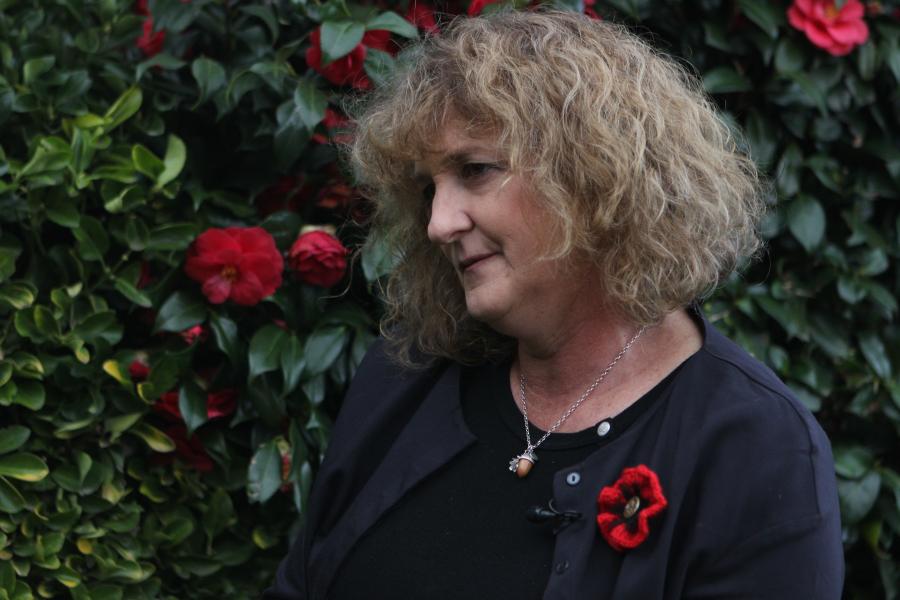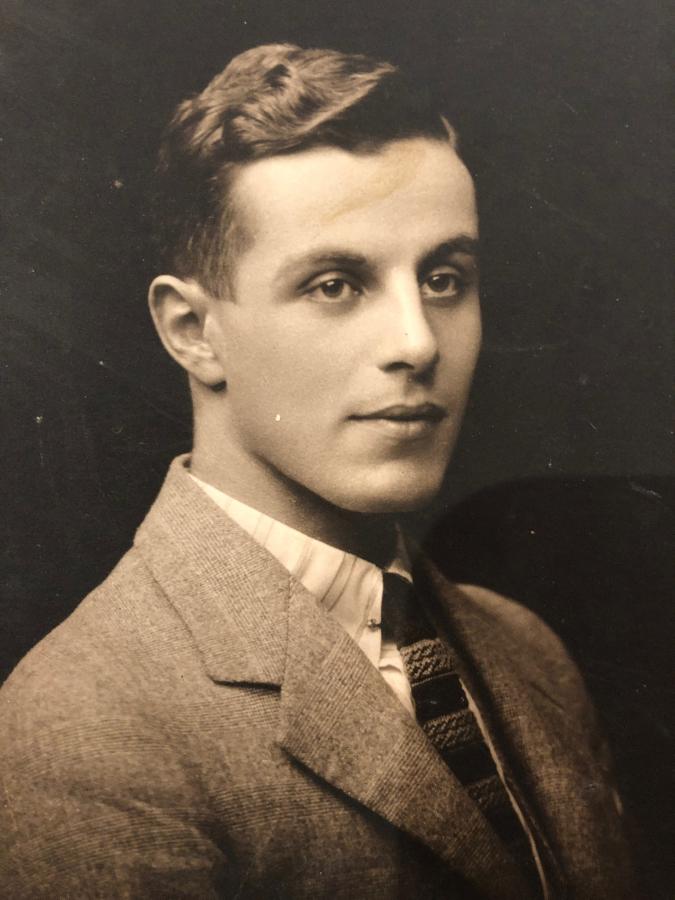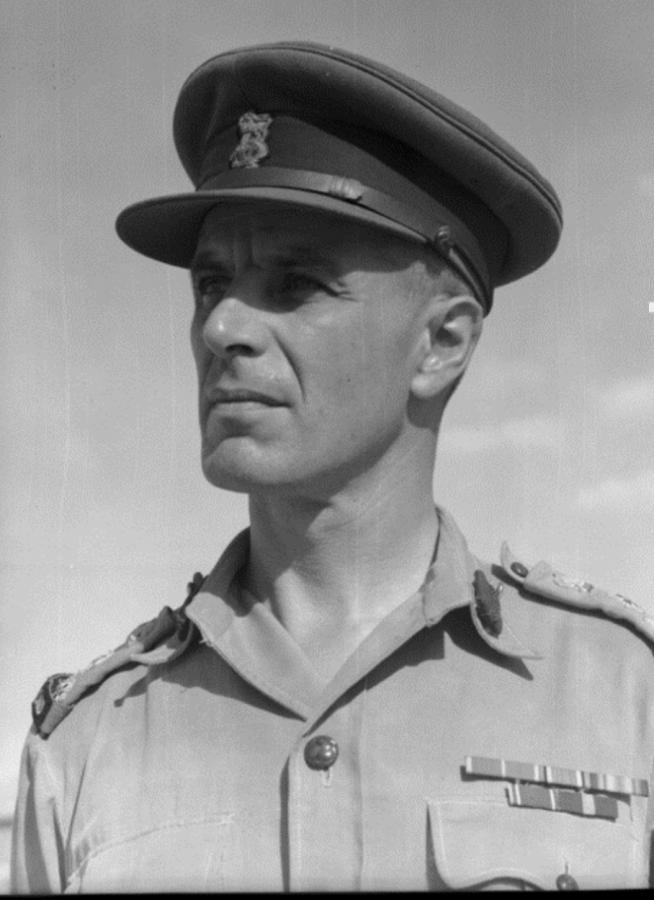'It was extraordinarily brave'

Sarah Worley: "For me, this project is all about connection."
Sarah Worley’s grandfather was severely wounded while serving with the Anzacs on Gallipoli and wore a brace for the rest of his life. But he never spoke about the First World War.
“It was extraordinarily brave for a kid from Invercargill in New Zealand,” Worley said.
“He signed up and went in October 1915, and he served for about four months before he was badly injured and evacuated to hospital in Alexandria in Egypt.
“He was shipped home in February, and it broke him. He had failed the medical … so they enlisted him because he was a mechanic, not because he was physically able to be a corporal in the New Zealand Rifle Brigade.”
Like many First World War veterans, her grandfather, Francis Ruck, never talked about his experiences, but when Sarah Worley heard about the 5,000 Poppies project four years ago she was determined to pay tribute to her grandfather’s sacrifice and all those who served.
“We didn’t even know he had medals until about a year ago,” she said. “He never referred to it at all, but my grandmother talked about it. Because of the way he was injured, he had to wear a brace … this leather brace that held him together, and it used to chafe, and it used to be so annoying, and she used to have to bandage him underneath it.
“She talked about the unpleasant task of doing that, of him being grumpy about needing to be helped every day because of that loss of ‘mana’, which is a New Zealand word, and of him having to rely on other people when he came home just to function daily, but he never talked about it …
“My dad knew nothing at all other than that he’d been injured at Gallipoli. We don’t know where. We don’t know how. We just have his record that says he was wounded and then evacuated.”

Harry Selwyn Kenrick CBE DSO served on the Western Front from 1916-1919.
Photo: Courtesy Sarah Worley
Since then, Worley has been lovingly knitting and crocheting poppies in honour of those who served as part of the 5,000 Poppies project.
The project was started by co-founders Lynn Berry and Margaret Knight more than five years ago as a personal tribute to their fathers’ service during the Second World War, but it soon captured the public imagination, inspiring more than 50,000 volunteers around the world.
It grew into a world-wide community project culminating in a moving tribute of 62,000 poppies at the Australian War Memorial in Canberra as part of a five-week commemorative program to mark the centenary of the Armistice that ended the First World War.
For Worley, who moved to Australia a decade ago, the tribute at the Memorial is particularly special.
Her husband’s grandfather, Harry Selwyn Kenrick, served on the Western Front and took part in New Zealand’s last major action of the war, liberating the French town of Le Quesnoy which had been under German control since August 1914.
“David’s grandfather scaled a 40-foot medieval wall on a ladder to help liberate the town,” she said. “It had been captured by the Germans, and on the 4th of November 1918 – just a week before the war ended – the New Zealanders scaled these walls, literally with a ladder, and liberated the town.
“They were heroes, and today New Zealand is still represented there in street names and on buildings. There’s Place des All Blacks and all that sort of thing … But when you go there it’s quite emotional. You just can’t get your head around the incredible bravery of 20-year-old boys, at the end of their campaigns, when they’d already been serving for years, and had been injured, and sent back to the front line, that they had the bravery to do it.”

Harry Selwyn Kenrick CBE DSO served as a Lieutenant with H Company, NZ Rifle Brigade, 4th Battalion, during the First World War.
Photo: Courtesy Sarah Worley
For Worley, it was important to remember their service and sacrifice. She was particularly moved by a memoir her husband’s grandfather wrote in his sixties as a retirement project using his diaries and letters from the First World War.
“It’s a fascinating collection of dates and battles, but there is no emotion,” she said.
“He talks about his captain putting his head up over the parapet and being shot through the helmet, and being covered in his blood, and he is obviously just absolutely stunned at the time, but he talks about how the guy knew that it was going to happen. They’d had this conversation the day before, and he had said to him, ‘You’re going to survive and I’m not going to,’ and within 24 hours, he was holding his captain. It’s horrific…
“He talks extensively about it being luck, about the mud at Passchendaele, and about being lucky because the shells hit the mud, exploded, and were contained in the mud.
“He talks about sheltering in parapets, and bombs landing on the roof, and going off, and that somehow they all survived – deaf in one ear – but they all survived, and it was just luck where it landed.
“He constantly talks about how it was nothing to do with skill, or bravery, or command, it was about luck whether you survived over your mate.
“And there is a lot of talk about mateship, of meeting up with the guys that they hadn’t seen 40 years later, and being able to connect through mateship.”

Harry Selwyn Kenrick served as a Brigadier with the NZ Medical Corps in the Middle East and Europe during the Second World War.
Photo: Courtesy Sarah Worley
When the Second World War broke out, he went to war again, as did Worley’s maternal grandfather and two great uncles.
For her, the poppies are a moving tribute to their sacrifice and the shared Anzac spirit between Australia and New Zealand.
“I have some concerns about the glorification of war, but then you see people making those connections, and getting emotional, and then finding their poppy that they made for their grandfather … it’s just beautiful,” Worley said.
“My dad keeps saying, ‘It’s not about glorification, is it?’ Because there was no glory. Dad was shattered. He came back broken.”
Worley has since travelled the world with the poppies, helping with the installations at Federation Square in Melbourne, the Chelsea Flower Show in London and the battlefields of northern France to commemorate the 100th anniversary of the battle of Fromelles.
“It’s given me a focus that I didn’t have,” she said. “For me, this project is all about connection: it’s connection with my grandparents, it’s about a connection with my dad, it’s about connection with my husband whose grandfather was a significant figure in both the First and Second World Wars, and it’s given me a connection with a group of women in Melbourne who are just lovely, who I had never anticipated meeting or being able to have this connection with, week after week, over something that’s so pliable, gorgeous and creative.
“They’re an amazing group of women, and it’s just so inspiring ... It’s beautiful.”
The 62,000 Poppies display will be open from 9 am to 10 pm daily until 11 November as part of the Memorial’s five-week Honour their Spirit commemorative program marking the centenary of the Armistice on Remembrance Day 2018.
Read the story behind the 5,000 Poppies project or watch the videos.